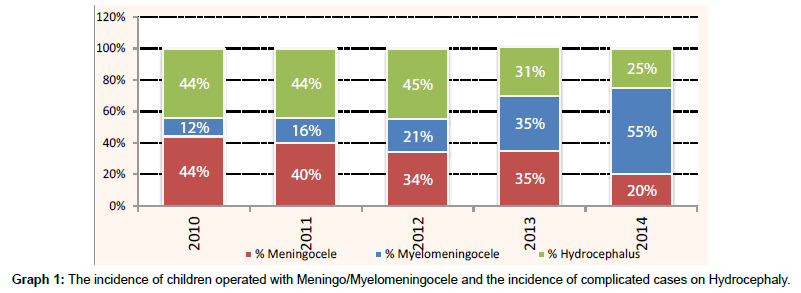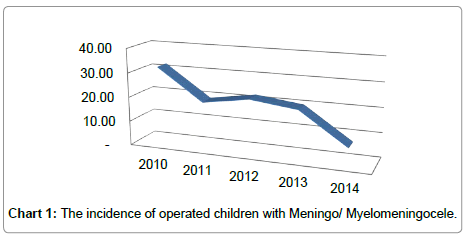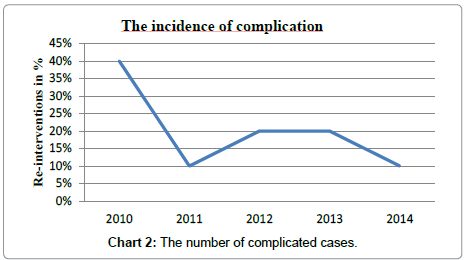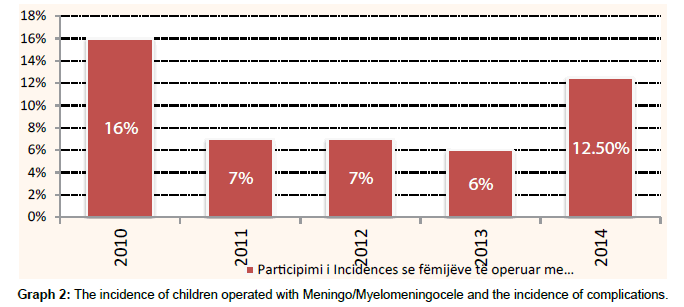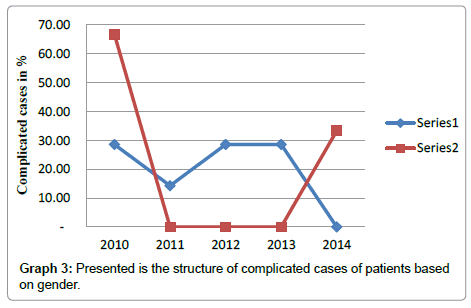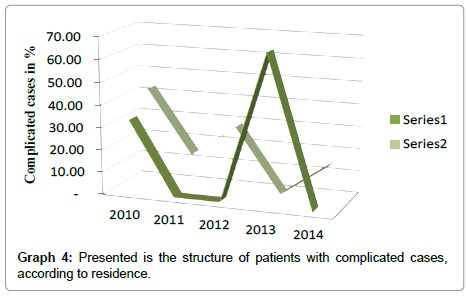Research Article, J Nurs Patient Care Vol: 2 Issue: 1
The Incidence of Operated Children with Meningomyelomeningocele
Gjonbalaj FF*
Nurse Anesthetist, University Clinical Center of Kosovo, Pristina, Kosovo, Southeastern Europe
*Corresponding Author : Flora Florije Gjonbalaj
Nurse Anesthetist, Faculty, University Clinical Center of Kosovo, Pristina, Kosovo, Southeastern Europe
Tel: +37745437594 E-mail: flora_gj@hotmail.com
Received: April 27, 2017 Accepted: April 20, 2017 Published: April 27, 2017
Citation: Gjonbalaj FF (2017) The Incidence of Operated Children with Meningomyelomeningocele. J Nurs Patient Care 2:1.doi: 10.4172/2573-4571.1000113
Abstract
- Meningo/myelomeningocele is the most common malformation of medulla spinalis. When people talk for Spina Bifida, often they refer to it as myelomeningocele, which is known as the most serious form. Research objectives Our research is the creation of some statistics for the incidence of children operated with meningo/myelomeningocele, gender, age, place of residence, and the incidence of complicated cases in Hydrocephaly, in the period from April 2010 to April 2014. Hypothesis H1: The incidence of children operated with meningo/myelomeningocele. H2: Complications of meningo/myelomeningocele with Hydrocephaly. Purpose The aim of this study is to raise health commitment, public attention for patients affected by meningo/myelomeningocele, to analyze the incidence of these children who have been operating in our hospital, also treatment and postoperative complications. Material and Methods In this study, we have used extracts from the protocol of neurosurgical operative hall in UCCK in Pristina. It is a retrospective study of the incidence of operated children with Meningo/Myelomeningocele. We have analyzed in a retrospective form all clinical data. The samples are 75 children operated with meningo/myelomeningocele in the hall of Neurosurgery at UCCK in Pristina, during the period from April 2010 to April 2014. Results The general number of children being born with defects and different pathologies of the neural tube from April 2010 to April 2014 is 133. The incidence of operating children with Meningo/Myelomeningocele, in the period from April 2010 to April 2014 in the hall of neurosurgery at UCCK in Pristina is 75 cases, of which 48 (64%) are diagnosed with Meningocele (DS=5.31), 27 (36%) are diagnosed with Myelomeningocele (DS=1.94). From these cases, 31 (38%) were registered from urban areas (r=.371,p<0.01), 44 (62%) were registered from rural areas (r=.536,p<0.01), 48(67%) cases were females, while 27(33%) were males. Out of the 75 children operated with Meningo/Myelomeningocele 10(14%) cases have suffered complications accompanied with Hydrocephaly (DS=1.22). The average age of operated children was 4-5 days. By making correlation analysis, it was found a significant report in the structure of operated children with meningo/Myelomeningocele, and the incidence of children with complications with hydrocephaly. Conclusion Out of the 75 operated children with Meningo/myelomeningocele, 10 cases have suffered complications accompanied with Hydrocephaly; time of intervention was after 7-20 days. 3 (30%) cases were from urban areas, 7 (70%) cases were from rural areas. 7 (70%) cases were females and 3 (30%) were males. By making a correlation analysis and standard deviation, we have reached the following values: The incidence of operated children with Meningocele: DS=5.31, The incidence of operated children: DS=1.94 The incidence with complications in Hydrocephaly: DS= 1.22, r=.961, p=.009 (p<0.01)
- Complications according to residence: DS= .707 Village: DS= 1.14, r=.539,p<.0.01 City: DS=.894, r=.371,p<0.01
- Complications according to gender: r=.920, p<0.01 Based on these statistical analysis we see that the correlation of this data is significant.
Keywords: Meningo; Myelomeningocele; Incidence
Introduction
The incidence of operated children with Meningo/ Myelomeningocele
Meningo/myelomeningocele is the most common malformation of medulla spinalis. When people talk about Spina Bifida, it is often referred to as myelomeningocele, which is known as the most serious form.
Regarding the forms of Spina Bifida, they are ranked from medium form, soft form, up to its heaviest presentation form. Based in its appearance, it is divided into: size and location of the open part of the spine, and how much the backbone and the nerve fibers are affected.
Meningocele (without neural elements, nerve fibers): It is the simplest form of Spina Bifida. Meninges and cerebral fluid do not have neural elements and this space communicates with the spinal canal.
Myelomeningocele (contains nerve fibers): In this defect, besides the cerebral fluid, there are neural elements, which are interpolated in the defect section through the spinal canal. As a result of this defect remains a soft unprotected part which may appear as a bump through the skin in the form of a dark bag. A layer or a thin membrane, which wraps the fluid that protects the brain and the marrow, covers this bag.
Research Objectives
Our research is the creation of some statistics for the incidence of children operated with meningo/myelomeningocele, gender, age, place of residence, and the incidence of complicated cases in Hydrocephaly, in the period from 2010 to April 2014 [1].
Hypothesis
H1. The incidence of children operated with meningo/ myelomeningocele.
H2. Complications of meningo/myelomeningocele accompanied with Hydrocephaly.
Purpose
The aim of this study is to raise health commitment, public attention for patients affected by meningo/myelomeningocele, to analyze the incidence of these children who have been operated to us, also treatment and postoperative complications.
Theory and the State of Research
Spina bifida refers to a birth defect, which includes the incomplete closure of the backbone.
Most of these are located in the lumbar region (the lower part of the backbone), but also in the thoracic and cervical region (the neck).
The number of complications with meningo/myelomeningocele accompanied with Hydrocephaly is 10 out of 75 operated children in the period from April 2010 to April 2014 in the hall of Neurosurgery in UCCK in Pristina. The cause of this malformation, meningo/ myelomeningocele is unknown. However, the low level of folic acid in a woman’s body before and during pregnancy has an important role in preventing and reducing a birth defect, such as meningo/ myelomeningocele. Folic acid (B vitamins or folate) is important for the brain and proper spinal development.
If a child is born with meningo/myelomeningocele, the next child in that family has a higher risk to be born with such a defect, compared with the general population. However, in many cases, there is no relation with the family.
During the second quarter, pregnant women should repeat blood tests and prenatal controls, which help to diagnose any defect that may occur to the baby. This checkup is done for meningo/ myelomeningocele, DS, and other congenital pathology in children [2]. The woman that holds a baby with meningo/myelomeningocele has a higher level than the normal value of a protein called alphafetoprotein maternal (AFP).
If the test is positive, further testing is required to confirm the diagnosis. Such tests may include Ultrasound and Amniocentesis
Tests that should be done to children born with defects are X-rays, ultrasounds, a CT or MRI of the spinal area.
Just meningo/myelomeningocele does not create intellectual impairment but if it is not treated well and in time, it can be complicated into hydrocephaly. The most frequent complications that are caused are:
Urinary infections
Decubitus or wounds
The baby born with the defect of the backbone (neural tube) needs a specialized examination in many areas. The simplest way of evaluating the movement of your child’s feet is by looking at each node and seeing if there is any movement or not. The three nodes that you should check are the hips, knees, and ankles. After birth, surgery is recommended to repair the defect. Before surgery, the baby should be treated carefully to reduce the damage of the exposed spinal cord.
Usually surgical treatment is recommended within the first day of life. The main surgical aim in this stage is to put the spinal cord back into the spinal canal, in order to make an intervention in the defect of the backbone and to cover the damaged area with healthy, normal skin.
There are two hypothesis when it is the appropriate time for the operation:
First hypothesis: The operation should be done within 36-48 hours after birth.
Second hypothesis: After 5 days that we are sure that the child is examined correctly and has a general stable condition, also to be sure that parents understand the seriousness of the problem.
Early operative treatment for the newborn is to preserve as much as possible, neural elements, especially those that are functional. If we consider these factors, then the sooner the better because the elimination of the bag defect is done, the coverage of damaged skin with healthy skin, and preservation of neural elements [3].
In the first days after surgery, it is essential to preserve the integrity of the wound not to have any infection. It is preferable to keep the child face down; also, it is preferable not to move much with feet, if there is any movement, the skin should not be withdrawn, so the tension on the wound should be very low. Around the tenth day, the condition of the wound is evaluated. To those children to whom Hydrocephaly is developed this usually happens between the fifthfourteenth days.
The final result is dependent from many factors:
Size and location of spinal defect.
The tempo in which Hydrocephaly is developed.
Infections as a complication.
Surgery and techniques with which the operation was conducted.
Rehabilitation and motivation of family.
According to the world literature, mortality of these children in the first decade is quite large in developed countries, in our country there is not any accurate statistic.
The Importance of the Study
This study for parents and caregivers of children with neural tube defects provides some data for the condition of children with congenital problems, which can occur frequently. This study provides information on the treatment and consequences with which children with Meningocele/Myelomeningocele are faced with starting from birth and throughout their lives.
A positive attitude towards these children will motivate them to develop their physical, psychological, and intellectual skills, whereas a negative attitude towards these children can cause complex reactions and drug addiction. On the other hand, their excessive protection prevents normal development of personality, and physical capacity of these children.
Material and Methods
In the study, we have used extracts from the protocol of neurosurgical operative hall in UCCK in Pristina. This is a retrospective study on the incidence of operated children with Meningo/Myelomeningocele. We have analyzed in a retrospective form all clinical data.
The samples are 75 children operated with neural tube defects, meningo/myelomeningocele in the hall of Neurosurgery at UCCK in Pristina, during the period from April 2010 to April 2014.
Results
The general number of children born with defects and different pathologies of the neural tube from April 2010 to April 2014 is 133. The incidence of operated children with Meningo/ Myelomeningocele, in the period from April 2010 to April 2014 in the hall of neurosurgery at UCCK in Pristina is 75 cases, of which 48 (64%) are diagnosed with Meningocele (DS=5.31), 27 (36%) are diagnosed with Myelomeningocele (DS=1.94).
Of these cases, 31 (38%) were registered from urban areas (r=.371, p<0.01), 44 (62%) were registered from rural areas (r=.536, p<0.01), 48(67%) cases were females, while 27(33%) were males. Out of the 75 children operated with Meningo/Myelomeningocele 10(14%) cases have suffered complications accompanied with Hydrocephaly (DS=1.22). The average age of operated children was 4-5 days. By making correlation analysis, it was found a significant rapport in the structure of operated children with meningo/Myelomeningocele, and the incidence of children with complications accompanied with hydrocephaly.
Results of quantitive data
Medical and surgical management of these children during the hospitalization is studied in detail to the default parameters. The average age in intervention time of Meningo/ Myelomeningocele is 4-5 days. Statistical analysis showed that the intervention of the defect Meningo/myelomeningocele before 48 hours has reduced the appearance of complications accompanied with Hydrocephaly. The average time in the intervention of complicated cases was 5 days.
This observation is statistically significant and shows that healing factors after intervention of myelomeningocele represent the most important factor of risk for development of complications in Hydrocephaly. In our study, which includes the period from April 2010 to 2014, we have a total of 75 children operated with deformation of the neural tube, of which 48 (64%) with medical diagnosis Meningocele, 27 (36%) with medical diagnosis Myelomeningocele, 10 (14%) of them had complications which are accompanied with Hydrocephaly. Only 41 of them are in an average economic situation, while others have certain difficulties, respectively they need help.
Results of qualitative data
Based on percentage, in tabular and graphical form, we have shown the incidence of operated children in the hall of neurosurgery at UCCK in Pristina and complications accompanied in Hydrocephaly during the annual period April 2010 to 2014 (Tables 1 and 2) (Graph 1). In the study for presentation of data we have used Microsoft Excel and statistical program SPSS.
| The incidence of children operated with Meningo/Myelomeningocele | 2010 | 2011 | 2012 | 2013 | 2014 |
|---|---|---|---|---|---|
| Meningocele | 17 | 10 | 10 | 9 | 2 |
| Myelomeningocele | 8 | 4 | 6 | 9 | 6 |
| Anomali (Hydrocephaly) | 17 | 11 | 13 | 8 | 3 |
| % Meningocele | 44% | 40% | 34% | 35% | 20% |
| % Myelomeningocele | 12% | 16% | 21% | 35% | 55% |
| % Anomali (Hydroceohaly) | 44% | 44% | 45% | 31% | 25% |
Table 1: The incidence of children operated with Meningo/Myelomeningocele and the incidence of complicated cases on Hydrocephaly.
| Cases | 2010 | 2011 | 2012 | 2013 | 2014 |
|---|---|---|---|---|---|
| ANESTHESIOLOGYAND REANIMATION CARE CLINIC Neurosurgery hall | 371 | 373 | 429 | 433 | 104 |
| The incidence of children operated with Meningo/Myelomeningocele | 25 | 14 | 16 | 18 | 8 |
| The complication of the incidence of children operated with Meningo/Myelomeningocele | 16% | 7% | 7% | 6% | 12.5% |
Table 2: The incidence of children operated with Meningo/Myelomeningocele and the incidence of complications.
In the chart (1) presented is the incidence of operated children with Meningo/Myelomeningocele, from April 2010 to 2014. Interventions are presented in percentage, where we can analyze and see that in 2010 from 371 overall cases has been intervened in 42 (12%) cases with different deformities of the neural tube, 25 (60%) are operated with Meningo/ Myelomeningocele. In 2011 from 373 overall cases has been intervened in 25 cases with different deformities of the neural tube, 10 (72%) of the cases are operated with Meningocele, 4(28%) of the cases are operated with Myelomeningocele [4].
In 2012, from 429 cases, it has been analyzed that in 29 (68%) cases with deformities of the neural tube, 10 (35%) of the cases are operated with Meningocele, 6 (21%) of the cases are operated with Myelomeningocele. In 2013, from 433 operated cases, it has been examined that, in 26 (6%) cases with deformities of the neural tube, 9 (50%) of the cases are operated with Meningocele. In 2014 (until April), from 106 cases, it has been inspected that in 10 (10%) cases with different deformities of the neural tube, 5 (50%) of the cases are operated with Meningo/Myelomeningocele. According to the correlational analysis we have significant values to the incidence of children operated with Meningo/Myelomeningocele and the incidence of complications accompanied with Hydrocephaly: r=.961, p=.003 (p<0.1), DS=1.58.
In tabular (Tables 1 and 2) and chart 2 it is presented the incidence of complicated cases in Hydrocephaly. From April 2010 to 2014, the number of complicated cases was 10(14%) out of 75 interventions with different deformities of the backbone (neural tube). In 2010, the number of complicated cases were 4 (16%) out of 15 general interventions. In 2011, the number of complications was 1 (7.2%) out of 14 interventions with Meningo/Myelomeningocele. In 2012, the number of complications was 2 (12.5%) out of 16 general interventions. In 2013, the number of complications was 2 (12%) out of 18 cases of total interventions. In 2014, the number of complications was 1 (10%) out of 5 cases of total interventions. The incidence of complications from 2010 to April 2014 is 10 cases or 14% of interventions in general (Graph 2). According to the correlation analysis, the incidence of complicated cases by a residence and gender has provided significant values. Gender: DS=1.22, r=.920, p=.-063 (p<0.01) Residence: DS=.707, r=.894, r=1.14, p<0.01.
In Graph 3, presented is the structure of complicated cases of patients based on gender. According to the data, the number of female patients is higher compared to the number of male patients. In 2010 we have 2 (50%) complicated cases of female gender and 2(50%) cases of male gender or 16% of the general number of interventions with congenital defects of the neural tube. In 2011, we have 1 (10%) complicated case or 20% from the general number of interventions [5].
In 2012, we have 2 (12.5%) cases of female gender or 3% of the general number of interventions. In 2013, we also have 2 (12%) cases of female gender from the general number of the interventions. In 2014 (until April), we have just one complicated case of the male gender of the general number of interventions.
In Graph 4 we have presented the structure of patients with complicated cases, according to residence. Based on retrospective data we have analyzed and presented these data. In 2010, the number of operated children from rural areas is 14 or 56% of the cases, whereas from urban areas this number is 11 or 44% of the total cases. In 2011, the number of cases from rural areas is 5(35%), whereas from urban areas it is 9(65%). In 2012, the number of cases from rural areas is 11(68%), whereas from urban areas it is 5(32%). In 2013, the number of patients from rural areas is 8(44%), whereas from urban areas it is 10 (56%) and in 2014 the number of patients from rural areas is 7(70%), whereas from urban areas it is 3(30%).
Discussion and Recommendation
Problems of the neural tube defects are a major source of disability, despite a significant decline in cases of the incidence. In World countries, it is often diagnosed in prenatal phase, and thus the operation of the fetus has been realized. Preliminary studies strongly suggest that at least a part of neurological abnormalities may be developed in the middle of pregnancy. Until now, around 400 operations of the fetus have been done in children with Myelomeningocele around the world [6].
During 12 years of study, the incidence of Myelomeningocele has decreased in a linear rate, for about 4.6 cases per 100.000 births per year. A summary of comparable reports in the northeastern region of the United States shows that a relatively stable linear decrease in the incidence of myelomeningocele has been continuing at this rate for the last 50 years. It is concluded that small local fluctuations and variability in data collection have shown a steady decrease in this phenomenon. Significant declines were seen in the rates of incidence in Hydrocephaly, compared to previous reports.
After comparisons of cases committed in the world and to us, we see that in cases with neural tube malformations compared with made research by Handikos, during the period from 2001-2009, and our research during the period from 2010-2014, there is positive decrease. It is worth noting that we do not have data for all born children with meningo/myelomeningocele, or with a neural tube defect [7].
General data, but incomplete in Kosovo, collected by Handikos, during the period 2001-2009, have 64 people registered with Spina Bifida. (HANDIKOS- Spina Bifida in Kosovo, December 2001).
Gender: 37 are males (58%) whereas 27 are females (42%).
Age: Under the age of 7 are 13 children, from age 7-17 there are 32 children, and from age 18 there are 18 children, whereas for one of the cases we do not have information for that age. From the whole group of 64 people, 52 of them were registered with paraplegia, 32 are with incontinence because of the damage to the spinal cord, 26 of them are presented in different levels of Hydrocephaly and 10 of them have had surgical intervention [8].
Conclusion
Out of 75 operated children with Meningo/myelomeningocele, 10 cases have suffered complications accompanied with Hydrocephaly; time of intervention was after 7-20 days. 3 (30%) cases were from urban areas, 7 (70%) cases were from rural areas. 7 (70%) cases were females and 3 (30%) were males.
By making correlation analysis and standard deviation, we have reached the following values:
The incidence of operated children with Meningocele: DS=5.31,
The incidence of operated children: DS=1.94
The incidence with complications in Hydrocephaly: DS= 1.22, r=.961, p=.009 (p<0.01)
• Complications according to residence: DS=.707
Village: DS= 1.14, r=.539, p<.0.01
City: DS=.894, r=.371, p<0.01
• Complications according to gender: r=.920, p<0.01
Based on this statistical analysis, we see the correlation of this data and that it is significant.
References
- Johnson A (2011) How to prepare for anesthesia, Chicago Tribune, USA.
- Li CH, Yew AY, Kimball JA, McBride DQ, Wang JC, et al. (2013) Comparison of operating field sterility in open versus minimally invasive microdiscectomies of the lumbar spine. Surg Neurol Int 4(Suppl 5): S295- S298.
- Werner D (1999) Disable village children. Handikos Spina bifida in Kosova.
- Wilson RD, Johnson JA, Wyatt P, Allen V, Gagnon A, et al. (2007) Pre-conceptional vitamin/folic acid supplementation 2007: the use of folic acid in combination with a multivitamin supplement for the prevention of neural tube defects and other congenital anomalies. J Obstet Gynaecol Can 29: 1003-1026.
- Lotfi MA (2001) Preoperative evaluation.
- Kliegman RM, Behrman RE, Jenson HB, Stanton BF (2007) Nelson Textbook of Pediatrics E-Book, Elsevier Health Sciences, Germany.
- Reigel DH, Rotenstien D (1994) Spina bifida. Pediatric Neurosurgery, Saunders, Philadelphia, USA.
- World Health Organization. Rehabilitation Unit, World Confederation for Physical Therapy, World Federation of Occupational Therapists, International Federation for Hydrocephalus and Spina Bifida (1996) Promoting the development of infants and young children with spina bifida and hydrocephalus : a guide for mid-level rehabilitation workers, Geneva : World Health Organization, Switzerland.
 Spanish
Spanish  Chinese
Chinese  Russian
Russian  German
German  French
French  Japanese
Japanese  Portuguese
Portuguese  Hindi
Hindi 